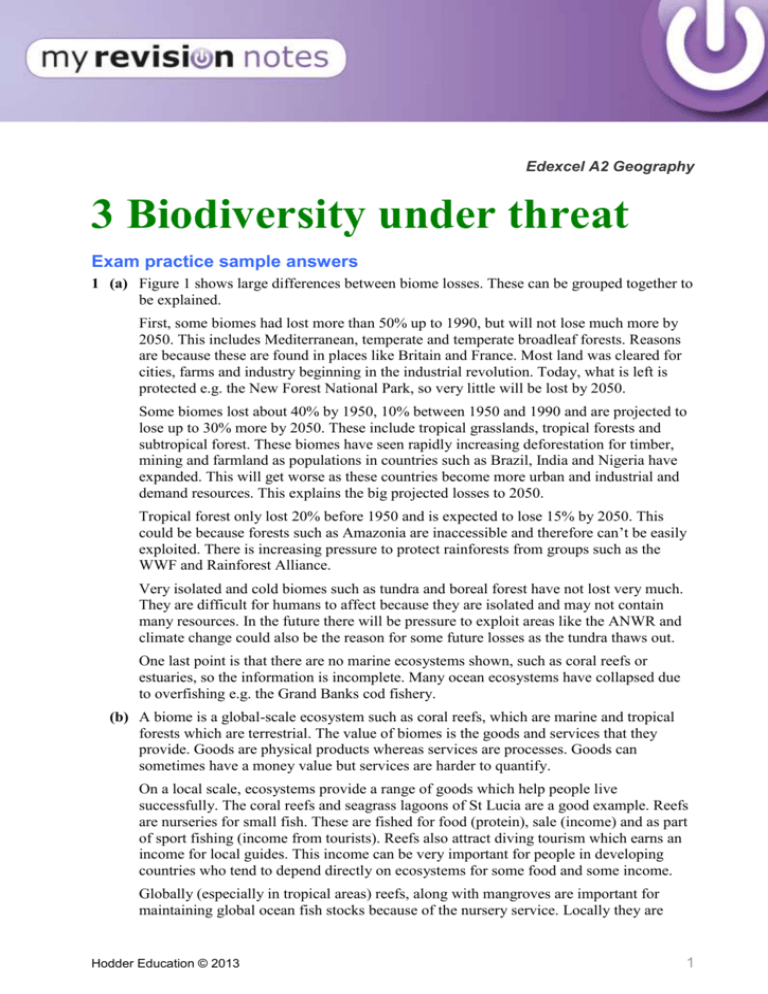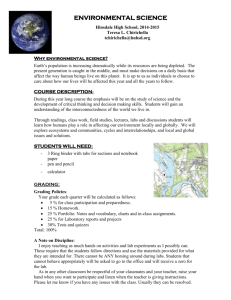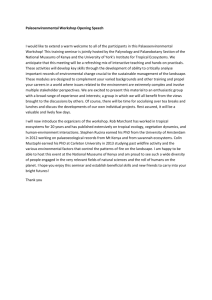Exam practice answers 3
advertisement

Edexcel A2 Geography 3 Biodiversity under threat Exam practice sample answers 1 (a) Figure 1 shows large differences between biome losses. These can be grouped together to be explained. First, some biomes had lost more than 50% up to 1990, but will not lose much more by 2050. This includes Mediterranean, temperate and temperate broadleaf forests. Reasons are because these are found in places like Britain and France. Most land was cleared for cities, farms and industry beginning in the industrial revolution. Today, what is left is protected e.g. the New Forest National Park, so very little will be lost by 2050. Some biomes lost about 40% by 1950, 10% between 1950 and 1990 and are projected to lose up to 30% more by 2050. These include tropical grasslands, tropical forests and subtropical forest. These biomes have seen rapidly increasing deforestation for timber, mining and farmland as populations in countries such as Brazil, India and Nigeria have expanded. This will get worse as these countries become more urban and industrial and demand resources. This explains the big projected losses to 2050. Tropical forest only lost 20% before 1950 and is expected to lose 15% by 2050. This could be because forests such as Amazonia are inaccessible and therefore can’t be easily exploited. There is increasing pressure to protect rainforests from groups such as the WWF and Rainforest Alliance. Very isolated and cold biomes such as tundra and boreal forest have not lost very much. They are difficult for humans to affect because they are isolated and may not contain many resources. In the future there will be pressure to exploit areas like the ANWR and climate change could also be the reason for some future losses as the tundra thaws out. One last point is that there are no marine ecosystems shown, such as coral reefs or estuaries, so the information is incomplete. Many ocean ecosystems have collapsed due to overfishing e.g. the Grand Banks cod fishery. (b) A biome is a global-scale ecosystem such as coral reefs, which are marine and tropical forests which are terrestrial. The value of biomes is the goods and services that they provide. Goods are physical products whereas services are processes. Goods can sometimes have a money value but services are harder to quantify. On a local scale, ecosystems provide a range of goods which help people live successfully. The coral reefs and seagrass lagoons of St Lucia are a good example. Reefs are nurseries for small fish. These are fished for food (protein), sale (income) and as part of sport fishing (income from tourists). Reefs also attract diving tourism which earns an income for local guides. This income can be very important for people in developing countries who tend to depend directly on ecosystems for some food and some income. Globally (especially in tropical areas) reefs, along with mangroves are important for maintaining global ocean fish stocks because of the nursery service. Locally they are Hodder Education © 2013 1 valuable natural defences against tropical storms. Degrading coastal salt marshes was one of the reasons Hurricane Katrina was so devastating in 2005 as the marshes could have dissipated the storm surge. Perhaps the most valuable biome is the tropical rainforest. It is sometimes called the ‘lungs of the earth’ because of the global role it has in carbon sequestration and oxygen formation. Essentially it regulates the composition of the atmosphere. Rainforests, temperate and boreal forests also regulate the water cycle contributing to cloud formation through transpiration and evaporation and intercepting rainfall. Interception slows down runoff and regulates river flow, preventing flooding. Tropical forests and coral reefs, with their huge biodiversity, are important global genetic stores. Genes from plants and animals can be used in making new medicines and breeding better crops. 2 (a) The red list is one way of seeing how threatened biodiversity is as it is done annually placing species, usually mammals, in one of ten categories from extinct to little concern. Figure 3 shows that it is a rapidly changing situation as at all levels on the scale some species are becoming more endangered and some less so, such as the humpback whale campaign (Greenpeace). There are a number of reasons why species are becoming more endangered. It can be to do with their habitat becoming more endangered, for example the melting of the Arctic ice has meant that polar bears are under threat as they have less opportunities for feeding or breeding. Some animals because of their large size are very vulnerable to hunters or they may have very valuable resources such as ivory from elephant’s tusks, and only strict legislation like CITES can make them less under threat. Animals that are unattractive to humans such as rats and mice are in danger of being wiped out. Equally badgers are thought to cause TB in cattle, so in spite of various Save Badger groups they are trapped or shot by farmers. Yet other species are becoming endangered because of the impacts of alien species — such as the red squirrel, which is being systematically overrun by grey squirrels and is only found in northern Britain now. Endemic species such as those in the Galapagos are especially vulnerable because of their comparatively small populations and inbreeding. Species can become less endangered, for example if there are campaigns to save them. Often as was the case with the giant panda, which was brought back from the brink, conservation strategies have to be combined with captive breeding in zoos. (b) The relationship between economic development and ecosystem destruction can be summed up by the following diagram. Hodder Education © 2013 2 If you start with least developed countries such as the Cameroon Republic they have very low levels of industrialisation, but need to export forest and mineral resources, to earn income. This leads to rainforest destruction, e.g. in Korup. As the population is rising in LDCs this exerts pressure on the land, as people chop down rainforest to subsist, or use coral reefs for fishing as in the Philippines. As countries develop, and begin to industrialise, this leads to rising demands for resources, and also a need for energy. In China they build one coal-fired power station each week, and levels of both air pollution and water pollution are exceedingly high, again damaging ecosystems by acid rain (Yunnan forests). While there are attempts to conserve species such as the panda, the pace of development is so great that ecosystems are being destroyed at an amazing rate. As these countries become more affluent their people have more purchasing power and they buy motor cars, so adding to greenhouse gas pollution — this phenomenon is global as it is happening all round the world. The resultant climate change is considered to be the greatest threat of all to biodiversity. When countries become more developed, theoretically they have the capital and technology to develop sustainable management and to conserve large areas of their valuable ecosystems. For some systems such as temperate forests and grasslands it is really too late, as up to 70% have been destroyed. Many countries however carry on as usual and ecosystem destruction (especially in lakes and rivers) continues as a result of eutrophication and other pollution. Some developing countries such as Tanzania and Costa Rica value their ecosystems and have excellent conservation strategies. Overall the pattern of ecosystem destruction can be matched to global economic development as, because of globalisation, systems are interconnected. Many of the ecosystems in tropical areas are under greatest threat, for example rainforest and reefs. Rainforests are being threatened for timber, and also are being chopped down and replaced by soya bean plantations (Brazil), or palm oil plantations (Indonesia) for producing biofuels. Globalisation has also led to world-wide tourism, and also industriallevel fishing, both of which have led to increased pressure on reefs which are already, for example in St Lucia, experiencing damage from development-related pollution and siltation. In conclusion, therefore, there is undoubtedly a strong link between economic development and ecosystem destruction. The Millennium Ecosystems Assessment suggested that all major ecosystems are under pressure, especially drylands and freshwater, and that this human-induced destruction is so great it is known as the sixth extinction. So great is the problem that as a result of International Biodiversity Year 2010, there is a plan to form an IPCC organisation to monitor world biodiversity loss. There are many systems in place such as the IUCN Conservation Frameworks, which should ensure that conservation strategies are strengthened. Hodder Education © 2013 3








